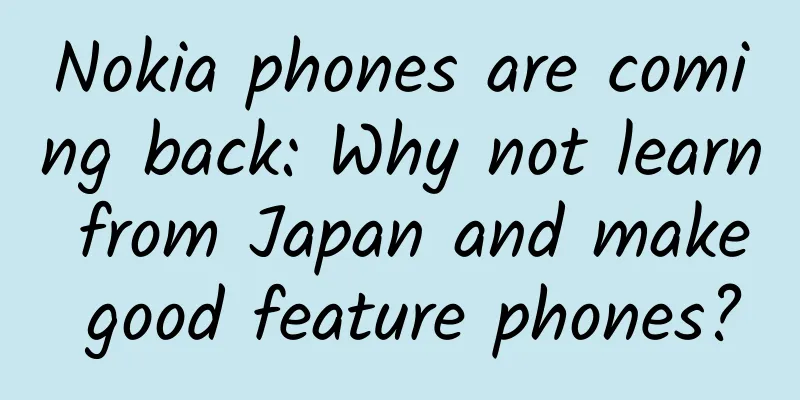Nokia phones are coming back: Why not learn from Japan and make good feature phones?

|
According to Forbes, Nokia is preparing to revive its mobile phone brand after announcing earlier this year that it would license the Nokia brand to the newly established Finnish startup HMD. Not long ago, Wang Jianya, president of the joint management team of Nokia Communications China and Shanghai Bell, announced to the industry the time point for the return of Nokia-branded mobile phones: the fourth quarter of this year. And after the expiration of the contract with Microsoft, Nokia mobile phones will return in the form of brand licensing. In May this year, Microsoft sold Nokia's feature phone business to Foxconn and Finland's HMD for $350 million. Foxconn acquired Nokia's factory assets and patents, and HMD obtained brand operations and patent rights. However, most people are not optimistic about Nokia's return to the smartphone market, because the fact is that the fierce competition in the smartphone market has left no room for Nokia to intervene. In China and most of the global markets, it is already a red ocean. According to IDC data, in the second quarter of 2016, Huawei, OPPO and vivo accounted for 47% of the domestic mobile phone market, while Apple, ranked fifth, only accounted for 7.8% of the domestic market. Although Nokia's technical patent strength is still strong, it has been basically absent from the development stage to the mature stage of smartphones. As a result, Nokia's smartphone products may be difficult to match user needs, and its manufacturing and design thinking and industrial design in the field of mobile phones may have lagged behind the times. Before Nokia was acquired, we saw that the software and hardware experience of Nokia's smartphones was relatively poor, and the only thing it could show off was the industrial design of Lumia. In fact, this is because Nokia's advantages in the feature phone era were too heavy, resulting in every step in the smartphone era being full of pain and discomfort, because essentially, Nokia lacks the genes of a smartphone manufacturer. Therefore, since Nokia has too heavy an advantage in the feature phone market, when Nokia returns to the market, it might as well play to its strengths and avoid its weaknesses and start with feature phones, which will make it easier to revive its brand value. Because for Nokia, the current favorable environment is that the size of the feature phone market is on the rise, and more and more users are tired of smart phones. This is because while the smartphone industry is unprecedentedly hot, many people miss those simple and simple feature phones that only have daily practical functions. In addition, in the emerging economy market of India, feature phones still dominate. In China, compared with smartphones, consumers such as the elderly may be more familiar with the use of feature phones and have certain feelings. In China, many users also have a nostalgic complex: the feeling of typing on the buttons of a feature phone has not been experienced for a long time. Even Microsoft's first quarter financial report this year showed that Nokia's feature phones outsold its smartphones. According to Microsoft's Q1 2016 natural quarterly financial report, a total of 2.3 million Lumia smartphones and 15.7 million feature phones were sold. Among them, Lumia phone sales fell 73% year-on-year. The data shows that Nokia's feature phone sales are 7 times that of its smartphones. In addition, market research firm Gartner has previously estimated that global mobile phone sales will reach 1.9 billion units in 2016, of which feature phones will still account for 300 million to 400 million units, mainly in emerging markets such as India. If Nokia can take over the majority of the feature phone market, its numbers cannot be underestimated. Foxconn's acquisition of Nokia is obviously also based on Nokia's brand and manufacturing advantages in the field of feature phones. On the one hand, as a giant in mobile phone OEM, Foxconn's feature phone orders are decreasing, but they have never stopped. In addition, Foxconn will obviously participate in the manufacturing, research, development, technical cooperation and distribution of Nokia-branded smartphones and tablets in the future. Thirdly, the three words Nokia still have huge brand surplus value in the world, and this surplus value is all associated with feature phones. Therefore, it is wise to first bring Nokia back to the mobile phone market by selling feature phones. But it is not easy for Nokia to make a good feature phone in the current era. Because Nokia's design thinking is obviously not the same as it was in the past when it launched a feature phone today, because the taste and aesthetics of today's users and their expectations for innovation in feature phones have greatly improved. On the one hand, the design of feature phones needs to meet the taste and personalized differences of current users, and on the other hand, it needs to be comparable to the current experience of smart phones in terms of intelligence, and it also needs to keep up with the trend in order to impress users. This is very difficult, but Nokia obviously has someone to learn from, which is the Japanese feature phone manufacturers. We know that the penetration rate of smartphones in Japan has always been low. Previous data showed that the proportion of smartphones in Japan was only 39%, while feature phones have been making a comeback in the past two years. In fact, this is not because Japanese smartphones are underdeveloped or technologically backward, but on the contrary, the Japanese are good at learning and making localized improvements and innovations based on their own national habits. The reason why feature phones are popular in Japan is that many mobile phone users prefer the most realistic physical feedback of typing on the keyboard. Traditional Japanese keyboard phones already supported many functions of smartphones long before smartphones became popular. Currently, Japanese feature phones are continuing to evolve and are customized with apps that consumers like. Not only can they flip the cover but also slide up and down. These phones can also receive TV signals and they can also receive information from TV stations. Even Japanese feature phones have functions that smartphones do not have, and these functions are well suited to the needs of their local users. For example, KDDI, one of the three major operators in Japan, has sold a large number of Garake mobile phones. The so-called garakei mobile phones refer to the fact that no matter how the mobile IT technology in the world develops, Japan has independently developed its own special mobile phones. KDDA cooperated with Sharp to launch the AQUOSK, a high-end LTE mobile phone equipped with LTE, a quad-core processor, touch screen, running APP, and supporting the most important information software line in Japan. This type of mobile phone looks like a flip-cover feature phone. There is news that the Japanese even made the iPhone into a flip phone, and its appearance design is also quite amazing and refreshing. In addition, Japanese feature phones have a good experience in many aspects, whether downloading apps or searching, shopping, sending emails, music, reading, social login, etc. The game customization service of Japanese feature phones is very developed, which basically meets the general needs of Japanese mobile phone users for mobile phone intelligence. Up to now, Japanese feature phones have actually evolved to a very high level and are not much different from smartphones. We can see that Japanese feature phones are actually not backward. While they have the experience of smart phones, they also combine the advantages of touch screens and keyboards and have their own characteristics. This is actually worth learning from for Nokia. There is no doubt that Nokia needs to have a clear brand identity when returning to the mobile phone market. Compared with the increasingly homogenized smart phone market, traditional feature phones have their own characteristics, with different shapes such as flip cover and side sliding cover. In particular, many of Nokia's previous feature phones have ingenious designs and are worth collecting. But for Nokia, if it wants to expand its feature phone sales globally, in addition to considering the ease of use of simple and convenient feature phones, the difficulty lies in how to do what Japanese feature phone manufacturers can do, integrating the traditional keyboard or flip design with the intelligent experience, and having an appearance that has both a nostalgic tone and conforms to the personalized aesthetic tendencies of current users. As mentioned earlier, Japanese feature phones combine the physical appearance of feature phones with traditional keyboard operations, but they also have the core of smart phones. The general operations and functions of smart phones can basically be realized, so this kind of Japanese feature phone can be said to be not inferior to smart phones to some extent, and it is very consistent with Japan's national conditions and user habits, and the fashionable appearance fits the aesthetic taste of Japanese users, but this is Nokia's weak point. As mentioned earlier, Nokia phones are very bad in the intelligent experience. Its initial failure also included mistakes in product strategy and product appearance. This is why the author suggested that Nokia learn from and imitate Japanese feature phones. Of course, this is also the direction that Nokia feature phones need to catch up and improve in the future. This is also why Japanese feature phones still occupy a certain market share in Japan and survive steadily. But according to previous news, Nokia's product strategy after its return is to enter the mid-to-high-end market. Obviously, this is because Nokia does not have a deep understanding of its own shortcomings and strengths. Previously, industry insiders believed that with the help of Foxconn's foundry supply chain, the mid-to-high-end market of around 3,000 yuan can still be supported. But whether the foundry advantage can bless the Nokia brand is still a question mark, because HTC is actually a lesson learned. However, there are also reports that HMD has revealed to Indian media that it will first bring Nokia back to the mobile phone field by selling feature phones. Therefore, Nokia's strategy should be to design differentiated and segmented mobile phone products based on its own advantages, and make a good backup feature phone, rather than focusing on the market share of smartphones. Because, from the current perspective, even if Nokia joins the Android camp, it is very difficult to get a share of it. Smartphone hardware technology has developed to a very mature stage, the competition is fierce, and the market is saturated. Whether in terms of software and hardware, talent reserves, channel marketing, and smartphone R&D capabilities, Nokia has basically completely lost its advantages. The feature phone brands of the year, such as Samsung, Sony, Moto, LG, and even Gionee, have basically transformed into smartphones. The saturation of the smartphone market has turned the feature phone market into a blue ocean with no competition. Therefore, this is also a big plus for Nokia's return. To sum up, if Nokia wants to make a comeback, it might as well learn from Japanese mobile phone manufacturers and focus on the localization and personalized needs of users, and do a good job of integrating feature phones with intelligent experience. In this way, Nokia can survive. If Nokia insists on making mid-to-high-end mobile phones in the Android system, then it will basically have no way out. As a winner of Toutiao's Qingyun Plan and Baijiahao's Bai+ Plan, the 2019 Baidu Digital Author of the Year, the Baijiahao's Most Popular Author in the Technology Field, the 2019 Sogou Technology and Culture Author, and the 2021 Baijiahao Quarterly Influential Creator, he has won many awards, including the 2013 Sohu Best Industry Media Person, the 2015 China New Media Entrepreneurship Competition Beijing Third Place, the 2015 Guangmang Experience Award, the 2015 China New Media Entrepreneurship Competition Finals Third Place, and the 2018 Baidu Dynamic Annual Powerful Celebrity. |
<<: Curved TVs become a new growth pole in the color TV industry
>>: Even if no one watches TV, TV media is still better than new media
Recommend
Many people died in Sichuan flash floods. What should you pay attention to when traveling in mountainous areas in summer? How to save yourself in the event of flash floods?
In the past two days, the flash flood in Longcaog...
Why is the flamingo pink? Because it is greedy...
Reference: The Smithsonian's National Zoo and...
9 cases and 12 methods to obtain seed users
Regarding seed users , there are several concepts...
Here is a case analysis of a blind date information flow advertisement, so that you won’t be lonely on Valentine’s Day!
Friends often ask, what are the differences in th...
I didn’t spend a penny on promotion and achieved 23 million app downloads!
The author of this article spent 6 hours to creat...
Real-life and analysis of community operations
The concept of community operation is very popula...
China Automobile Dealers Association: China Automobile Consumer Reputation Index in December 2021
On January 6, 2022, the China Automobile After-sa...
The same "fire-proof hood" in "Journey to the West", it turns out that everyone has seen it!
There is a story in Journey to the West, one of t...
Inventory of marketing cases of big-name manufacturers in Q1 2021
Spring is here and summer is approaching. In the ...
Brand marketing, how does Okamoto capture consumers?
In the context of consumption upgrading, Okamoto ...
Why do other people's hemorrhoids get better on their own when left alone, but mine are getting worse?
It is said that nine out of ten people have hemor...
How did it become a hit? A look at the development model of Sohu Video's self-produced dramas from "Fox in the Screen"
Since 2012, Sohu Video has been making further an...
WeChat Mini Program Development Process, How to Develop WeChat Mini Program?
WeChat Mini Programs are favored by many companie...
BYD Song L DM-i is about to debut, with a slightly reduced size, aiming for a price war
BYD's strength is obvious to all. It has won ...








![Blue Maple Graphic Game Visual 2021 PS Tutorial [HD Quality with Materials]](/upload/images/67cc065aefc93.webp)
